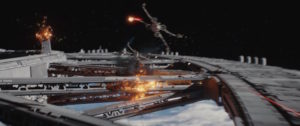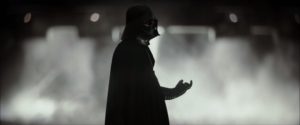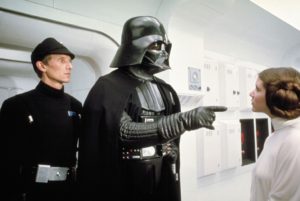
As the 89th Academy Award nominations have been selected, the latest edition to the Star Wars franchise, Rogue One: A Star Wars Story is once again represented in the Best Sound Mixing category. Christopher Scarabosio (re-recording mixer/sound designer) and Matthew Wood (Supervising Sound Editor) are no strangers to the Sound Editing and Sound Mixing categories in the Academy Awards. Rogue One: A Star Wars Story is the 8th film in the Star Wars franchise.
As directors change and bring a unique style to each Star Wars film, it is left to Christopher Scarabosio and Matthew Wood to preserve the sound of the Star Wars aesthetic soundtrack. Both Christopher and Matthew have worked on almost the entire Star Wars anthology. In an interview with Christopher and Matthew, they mentioned have access to over 50 years of Star Wars sounds. Sound Mixing takes much preciseness and technique of infusing old and new sounds together to create a harmonious sound. It is very important to use the older sounds correctly to keep the heart of Star Wars, but also as a different film to add in new sounds to keep the film fresh.

Specifically, the new sounds were imbedded in all the various planets, ships, weapons, troopers, and the new Droid (K-2SO). The planets included Lah’mu, Wobani, Yavin 4, Jedha, Coruscant, Eadu, Mustafar, and Scarif. Creating a new planet with sounds is no easy task. The planets differentiated from each other by having a multitude of ambiences that are appropriate for each location. Scarabosio and Wood explain the sound of each planet. “Scarif was like a beach location such as a tropical place, so it was imagined to sound like the tropics in space; along with a jungle atmosphere in space. Homestead is represented as windstruck, lonely, and desolate. Wobani would be sketchy with various creatures. Jeda would be a call to prayer,” they said. There were three new ships added into Rogue One. The sound from for the spaceships depended on what was propelling it as being a rocket or jet. The U-Wing had more of a rocket based starting point. All the planets and spaceships were all layered with signature sounds, finding interesting sound effects, from a mix of vintage and fresh sounds together.
Having all the entire collection of the Star Wars soundtrack does not necessarily make sound mixing/editing a breeze; there is a difficult aspect as well. When asked the most challenging part about Rogue One, Christopher and Matthew explained, “the spaceships were a bit of a challenge because they are such a big part of Star Wars, three new ships, and brand new weapons.”
As difficulty arises, so does an atmosphere of fun and a feeling of being proud of the sound. Some of the most exciting scenes were during the mixing session. In particular, “the scene when the Hammerhead pushes the two star destroyers as they crash into each other and mixing as the music was muted with loud sound effects.” Other proud moments for Christopher and Matthew are the destruction of Jeda, changing things up with sound so the audience does not get fatigued, and the shield.
The thought process going from The Force Awakens to Rogue One was a polar opposite. Rogue One’s story ends close to the beginning of the events in A New Hope; since classic sounds are involved, sound mixing and editing must be handled with extreme care. The original sounds used in the 1977 film were dusted off and enhanced with Atmos Sound. The classic sounds were then incorporated with new things in the environment so they meshed well with each other. As J.J. Abrams directed The Force Awakens and Gareth Edwards directed Rogue One, their styles vary tremendously, but the sound is constant. For the upcoming Star Wars: Episode VIII-The Last Jedi film, the plan is to continue the legacy from The Force Awakens.

The iconic voice behind Darth Vader returned to Rogue One. Both Christopher and Matthew were thrilled to work along side James Earl Jones recording and mixing his ADR lines, along with the breathing. They explained, “at 80 years old, Jones got right back in there and just did his thing. The original respirator was also used and it will probably never change.”
As exciting as James Earl Jones, it wouldn’t be a Star Wars film without a droid. Rogue One added a new and an exciting droid known as K-2SO. K-2SO was voiced by Alan Tudyk—Mr. Tudyk was on set the entire time. The voice for K-2SO was not greatly enhanced because the delivery of the character was very close to what the team was looking for. The slight sound voice enhancements to make him sound more robotic included flange, light process, and motors. All these are perfectly matched and mixed to create the final voice as we know as K-2SO. Out of all the characters, K-2SO recorded the most ADR lines. As mentioned by Christopher and Matthew, a good group of voice loopers usually assist with ADR lines. “K-2SO was recorded at Industrial Light and Magic (ILM) with a motion capture suit,” they said. “He was designed to be an elegant droid. The sound of his footsteps were meant to sound heavy.”
Scarabosio and Wood explained, “the post process for Rogue One lasted about 8-9 months.” The sound team went onto the set of Pinewood Studios. During their time at Pinewood, they began gaining motivation and creating fresh ideas. Sound evolved and changed over that period of time.
Future Star Wars films may have different writers and directors, but one constant remains. The sound team led by Christopher Scarabosio and Matthew Wood will keep the franchise in tact by using iconic sounds with deep care, mixing the old and new, and creating fresh sounds. As years pass by, the sound editing and sound mixing will keep Star Wars true to the heart and root of why it is one of the most successful and beloved franchises, due in large part to the likes of Christopher Scarabosio and Matthew Wood.





